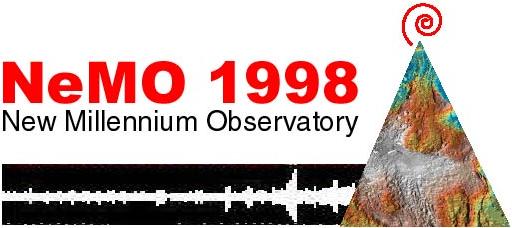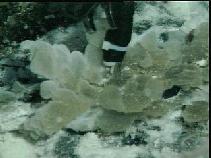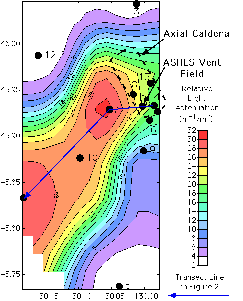WHAT'S NEW:
Deepsea Image Galleries on Multimedia page
(posted 9/15/98)
Eruption Confirmed!
New lava (rumbleometer stuck in flow) SE rift zone
(posted 9/1/98)
BACKGROUND:
Technology (ROV, ships, etc.)
Other 1998 Axial cruise reports
EXPEDITION:
Science Objectives
Calendar
Today's Science News
Participant Perspective
Teacher Logbook
EDUCATION:
Curriculum
Teacher Observations
Questions/Answers from sea
MULTIMEDIA:
(video clips, animations, sounds)

Questions and Answers from sea:
Send your question to the NeMO cruise(oar.pmel.vents.webmaster@noaa.gov)
Include your name (or school/group), age and City in your message!
(This is not limited to students!)
August 30, September 1, 2, 13, 20
September 20, 1998
Question:
How will all the the seismic activity occuring off the Oregon Coast effect the seismic activity on the land in Nothern Oregon? Thank you for your response.Karen Lynch- Portland, OR
Answer:
The seismic activity at Axial Seamount does in fact relate to land seimicity in the Pacific Northwest, but only in a long-term sense. The connection is plate tectonics. The seismicity recorded from Axial Seamount and other sites along the Juan de Fuca Ridge record the formation of new oceanic crust. This new seafloor is slowly (2 cm/year) carried toward the Oregon/Washingtom coast where it subducts beneath the continent of North America. This subduction process can cause large earthquakes beneath the coast, as well as affect faults inland. Also, the subducted material eventually melts and rises to the land surface as Cascade Volcanoes!Does a seismic event at Axial lead directly to land seismicity? Probably not. The seafloor plates are not perfectly rigid and therefore it is only the long-term accumulation of strain through time that is eventually transferred to the continent. The time scales and other aspects of this process are not well understood and it is hoped that continued study of the ridges will shed more light on this question.
Christopher G. Fox
September 13, 1998
Question: What is the "bag creature"? Andra Bobbitt, Seal Rock Oregon
Answer: A figment of overactive imaginations to some extent. The big jelly blobs we see around the vents are not creatures at all. [When they were first found, geologists decided that, since they weren't rock, they had to be animal and the name stuck.] If you look at them in the lab, they are like round lumps of Jello: transparent, often with white fuzzy growth on top. Under the microscope, there is no structure at all. Our microbiologists will be examining them because we believe they are sugar wastes produced by bacteria. So much is coming out that they stick together and form large blobs.
September 2, 1998
Question:
Does ROPOS ever get into water so hot that it melts the sub?
Arielle Garrett
Answer:
The answer is that there are a lot of parts and fittings that would be in big trouble in 100 degree water. In fact they have to be careful not to slide the wrong piece through the venting water. The probes, of course, are made to withstand a lot higher temperatures, upwards of 400 degrees celcius. (Some of the hydrothermal vents in the Ashes vent field of Axial have temperatures in excess of 300 degrees celsius).
September 1, 1998
September 1, 1998
Question:
If there was a plume(s) on the jan-feb eruption, did they stick around long enough to be studied? How big was the plume and does the plume hang around, move and is there a preferred direction of circulation within a plume? What is the effect of the plume fallout on the adjacent body of water?Jeff Goodrich, Environmental Middle School
Answer:

|
Area map of Axial region showing the plume represented by light attenuation anomalies. (click map for larger version). Light attenuation is measured with the CTD instrument. See Preliminary Results from the Wecoma Event Response Cruise, February 1998. (map: S.Walker/NOAA) |
Here's what I know. There was a fairly large plume that was streaming off to the west in the direction of the currents at that time. How big the plume was is poorly known simply because of the limited time available to the scientists on that first cruise (5days). Each of the black points in the picture above is the location of where water was sampled. As you can see the points were just able to outline the plume. The plume was initially characterized using a device referred to as a CTD/O. This device is lowered beneath the ship and measures conductivity (C) , temperature (T) , and depth (D) of the water as well as the concentration of particles. Particles are measured optically (O) by shining a light on them an then measuring how much light reflects back to the detector. In addition this device is able to collect water above the volcano, which allows us to measure the chemical properties of this water. Our expert out here says if they can get to the plume quickly enough they look for hydrogen and methane tracers. They found lots of methane in February just above the lava flows. Hydrogen and Methane are quickly utilized by organisms so later chemical investigations focus on more stable tracers like manganese, iron and CO2. Scientists think that these plumes may drift quite a long way from the source, but no one is out there looking for them, so how far they travel or how intense they can be is a bit of a mystery. Workers with the VENTS group believe that they have tracked these plumes as far away as Hawaii. The VENTS group is working hard to solve this problem using buoys that drift underwater at the depth of the plume (RAFOS buoys) and then come to the surface at a specific time. The drifters are then able to tell the scientists where the plume has been. The vented water is of course toxic to many organisms but is used as a food source by all the unique animals that we see at the bottom of the ocean out here. >P> Hope this helps. - Gene Williamson, Teacher at sea (with additional thoughts from shore)
August 30, 1998
Question:
Hi,
I am Christopher Wallace. I am 6 1/2. My Dad Kim told us a new vent was discovered while he was flying ROPOS. What are you looking for at a new vent? Do you expect to see a chimney form? Does that always happen? When will we see some pictures from the bottom? That's all
Christopher
Answer:
 Your Dad was flying ROPOS when "Cloud" vent was discovered. There are
scientists out here with many different interests, so we look for several things
when we explore hydrothermal vents. If one is a geologist they would be
interested in the rocks in the area of the vents. Is there new lava in the area
due to an eruption? What is the chemical composition of the rocks in the area?
What types of lavas do we see around the vent? How old are the rocks? If one
is a chemist they would be interested in the chemical composition of
the water
coming out of the vents. Does the water rise up from the vents and form a plume
after an eruption? If one is a biologist they would be interested in
the types
of animals and bacteria that live around the vents in these harsh environments.
Chimneys don't always form around hydrothermal vents. Most of the vents we have
been observing so far are called "diffuse" vents. We have seen a few
chimneys
near lava columns on this expedition. They form when there is an eruption due
to the heat that is escaping through the cracks in the lava. These are lower
temperature vents (2 - 50 degrees C) We are seeing diffuse vents in the area
where the latest eruption occurred (February 98). Chimneys form in areas where
there is high temperature water and lots of it rising up from a more
focused
source. They take longer to establish and last longer than the "diffuse" vents.
They have a good "plumbing system", so lots of hot water is forced up and out
of them. They form near longer lasting geological features like faults (cracks
in the seafloor due to movement of the seafloor by long term forces.
They can
get very hot (350 degrees celsius)!!! They last longer than the "diffuse" vents.
Your Dad was flying ROPOS when "Cloud" vent was discovered. There are
scientists out here with many different interests, so we look for several things
when we explore hydrothermal vents. If one is a geologist they would be
interested in the rocks in the area of the vents. Is there new lava in the area
due to an eruption? What is the chemical composition of the rocks in the area?
What types of lavas do we see around the vent? How old are the rocks? If one
is a chemist they would be interested in the chemical composition of
the water
coming out of the vents. Does the water rise up from the vents and form a plume
after an eruption? If one is a biologist they would be interested in
the types
of animals and bacteria that live around the vents in these harsh environments.
Chimneys don't always form around hydrothermal vents. Most of the vents we have
been observing so far are called "diffuse" vents. We have seen a few
chimneys
near lava columns on this expedition. They form when there is an eruption due
to the heat that is escaping through the cracks in the lava. These are lower
temperature vents (2 - 50 degrees C) We are seeing diffuse vents in the area
where the latest eruption occurred (February 98). Chimneys form in areas where
there is high temperature water and lots of it rising up from a more
focused
source. They take longer to establish and last longer than the "diffuse" vents.
They have a good "plumbing system", so lots of hot water is forced up and out
of them. They form near longer lasting geological features like faults (cracks
in the seafloor due to movement of the seafloor by long term forces.
They can
get very hot (350 degrees celsius)!!! They last longer than the "diffuse" vents.
ps-Christopher's dad is currently aboard the Ron Brown and is a member of the ROPOS team.